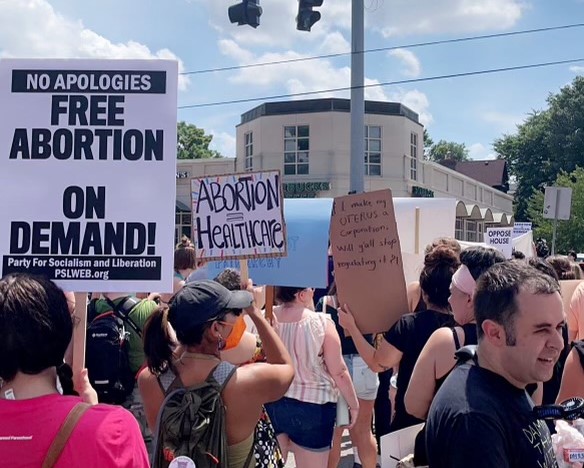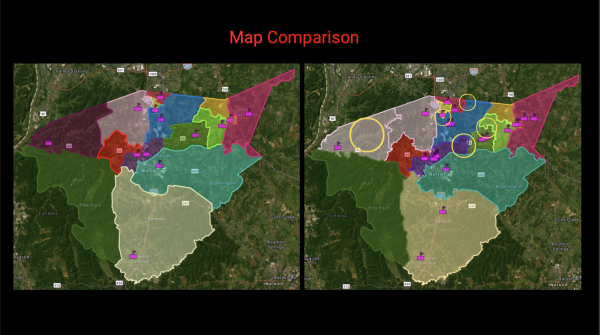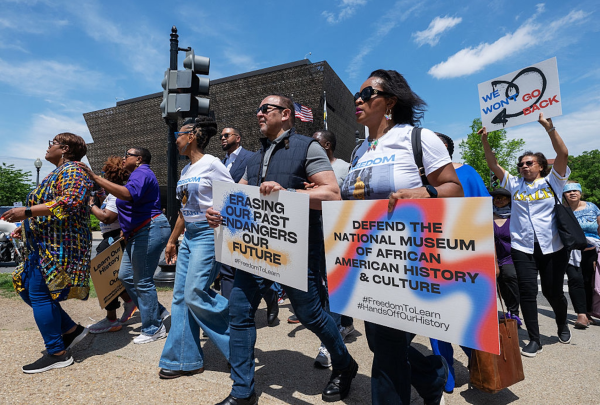The End of Roe

Protesters march down the street holding signs in the aftermath of Roe v. Wade being overturned. On July 4, 2022, citizens gathered in downtown Louisville, Kentucky on Baxter Avenue to show their distain to the state for its proposed abortion ban.
After nearly 50 years, it’s gone.
Roe v. Wade has been overturned.
Roe v. Wade was a 7-2 landmark Supreme Court decision made on Jan. 22, 1973. The court’s decision essentially legalized abortion in all 50 states. It was passed by a majority of seven justices who were appointed by both liberal and conservative presidents. Only two justices dissented who were also appointed by both liberal and conservative presidents. Overall, the case was bipartisan in its initial decision.
Jane Roe was a woman who’s real name was Norma McCorvey. She was a resident in the state of Texas that wanted to get her pregnancy terminated. She had given birth to two children previously and had given both up for adoption. This was a process that she did not want to go through again. Many rich women at the time would travel to different states where abortion was legal if they were to be in such a situation. However, McCorvey, like most impoverished women, did not have this option.
McCorvey quickly got in contact with two attorneys, Sarah Weddington and Linda Coffee. These two attorneys sued the local district attorney (D.A.), Henry Wade, on behalf of their client. Coffee and Weddington argued that Texas’s abortion ban was unconstitutional. The U.S. District Court for the Northern District of Texas heard McCorvey’s case and ruled in her favor. They then appealed the case to the U.S. Supreme Court. The Supreme Court sided with the decision made by the Texas court and also ruled in McCorvey’s favor. The court wrote its concurring opinion referencing the 14th amendment by stating that it was implied in the right to privacy provided in the amendment for a woman to have access to an abortion in the U.S.
This ruling would quickly cause outcry amongst the more conservative groups of U.S. society. Evangelical Christians, a group that previously would not participate in politics due to what they viewed as its immoral nature, began to vote with the promises from Republicans to work to overturn Roe v. Wade. Conservative politicians began discovering and exploiting loopholes in the initial decision that allowed them to restrict abortion as much as they legally could. Many extremists even resorted to violence. Since 1977 there have been eight murders, 17 attempted murders, 42 bombings, and 186 arsons targeted at abortion clinics and providers.
Over the years, Roe v. Wade was transformed from its initial place, a bipartisan Supreme Court decision, to a partisan one. The Republican party integrated their negative opinion on the case into their platform, and in retaliation, the Democratic party co-opted the defense of the case. Despite how partisan the case is in the political sphere, most Americans still hold a somewhat positive view of the case. In an NPR poll done in May 2022, it was revealed that around 64% of Americans didn’t want to see Roe v. Wade overturned.
However, on May 3, 2022 it was leaked to the media by an unknown source that the Supreme Court would be revisiting the Roe v. Wade decision and would likely be overturning it. Chief Justice John Roberts quickly confirmed the authenticity of the leak but said the court had not come to its final decision on the matter. This isn’t the first time a Roe v. Wade decision was leaked. Back in 1973, when the case was initially visited, the court’s decision was leaked before it was supposed to be revealed to the public as well.
On June 24, 2022, in a 5-4 decision, the Supreme Court officially reversed Roe v. Wade. They were visiting a case that dealt with Mississippi’s abortion restrictions, and the court decided that not only were these restrictions constitutional but that Roe v. Wade was not. In the majority opinion it was stated that in the current view of the court, Roe v. Wade was a judicial overreach and that nothing in the 14th amendment protected the right to receive an abortion. Five out of the six conservative judges voted to reverse the decision. Chief Justice John Roberts, the conservative judge who did not vote to overturn Roe v. Wade, voted with the majority on upholding Mississippi’s abortion restrictions but did not agree with throwing out Roe v. Wade altogether.
As of July 15, 2022, these nine states have completely banned abortion: Wisconsin, South Dakota, Missouri, Oklahoma, Texas, Arkansas, Mississippi, Alabama and West Virginia. These four states are expected to see bans soon: Idaho, Wyoming, North Dakota and Tennessee. Four state’s bans have been proposed or passed but are currently blocked by another sector of the state government: Utah, Arizona, Louisiana and Kentucky. In these nine states, abortion is legal for now, but there hasn’t been a final decision by lawmakers or courts: Montana, Nebraska, Kansas, Iowa, Michigan, Indiana, Pennsylvania, Virginia and North Carolina. Finally, in these 20 states abortion is currently legal or protected: Washington, Oregon, California, Alaska, Hawaii, Nevada, Colorado, New Mexico, Minnesota, Illinois, Maryland, Delaware, New Jersey, New York, Connecticut, Rhode Island, Massachusetts, Vermont, New Hampshire and Maine.
There has been extreme outcry amongst the supporters of Roe v. Wade in the aftermath of it being overturned. The U.S. has seen protests in cities across the country. California, Washington and Oregon have formed a West Coast Offensive that would legally protect those who traveled to their states to get abortions. California’s governor, Gavin Newsome, has also been quoted in saying his state would not collaborate with states where abortion was banned. Tension on the issue of abortion is at an all time high.









